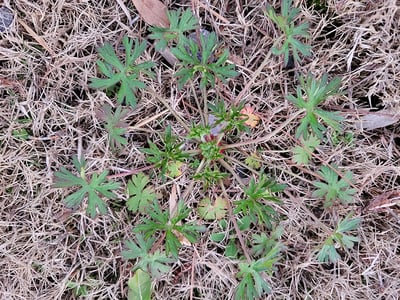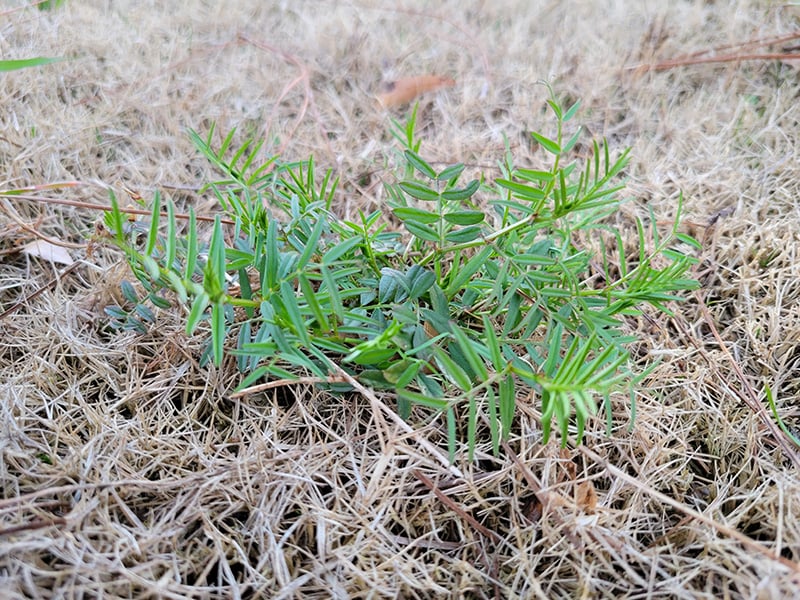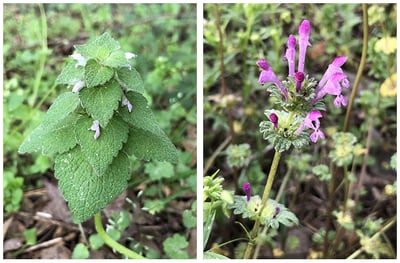

Our lawn weed of the month is vetch, because, here in the Southeast, it starts getting big during the warm spells of March. Vetch is a catchall name for many species of small vines that are closely related to peas. Yes, a vine can be a weed in lawns!
There are a couple hundred vetch species, but we only need to be concerned with the two species of vetches that commonly infest lawns and flower beds in the Southeast. You may even plant them on purpose if you plant a winter cover crop to fix nitrogen in your vegetable beds or grow feed for your livestock.
- Vicia sativa, common or narrowleaf vetch: broadleaf winter annual; native to Europe and Asia; "sativa" means cultivated or planted on purpose.
- Vicia villosa, hairy vetch: broadleaf winter annual or biennial; native to Europe, Asia, and Africa; "villosa" means hairy and describes the hairy leaves and flowers.
We'll cover how to identify and control both of these vetch weeds.
General Vetch ID Features:
To control vetch weeds, we first need to learn how to identify them.
- Family: Fabiaceae, commonly called the bean, pea, or legume family
- Habit: Short 2-3’ vines, often developing several stems from a central growing point and densely mounding on itself or twining to form a little vining weed. When there is nothing for it to climb it sprawls along the ground in a mounded up mat, like a little creature.
- Roots: Common vetch's roots are multi-branched and fibrous, sometimes spreading a little underground via short rhizomes; hairy vetch has a taproot. Both species fix nitrogen from nodules on their roots (nodules are white-colored and visible with the naked eye).
- Leaves: To the untrained eye, the leaves on these two vetches look similar to each other. Both common and hairy vetch have pinnate (feather-like) leaves with branched tendrils at the ends that helps the short vines climb up other plants. Common vetch is a plain light green in color, while the leaves of hairy vetch are more gray-green and often have a soft hairy fuzz (degree of fuzz is variable).
- Flowers: The flowers on these two species are very different from each other. Common vetch has two pea-like, purple, rose, pink, or lavender flowers nestled in the leaf axils. Hairy vetch has a showy, pretty flowerhead with anywhere from 5 to 40 hairy, bluish or purple-lavender flowers arranged on tall racemes.
- Fruit/seed: A dainty legume pod with “pea” seeds inside. Common and hairy vetches spreads like wildfire via these seeds.
Common and hairy vetch are cool season annuals that germinate in the fall and really start zooming up during warm spells in winter and spring. I find common vetch all over my garden in the lawn and even in the mulched beds. It will thickly self-sow and becomes apparent amongst dormant perennials, dormant shrubs, and my dormant Zoysia lawn.
Common vetch is "common" because it's quite the opportunist - growing anywhere and climbing up anything, including other weeds. If nothing to climb, it happily sprawls along the ground.
Common vetch climbing up roadside grasses in late spring.
The flowers of common vetch are like sweet-peas, but much less showy.

A side view of vetch flowers.
The tiny seed pods are edible, but you'll have to work hard picking lots of pods to get enough for even a side dish of legumes.

Common and hairy vetch thrive in the acidic soils of the Southeast and they are drawn to garden habitats because they like the extra water we provide. For that reason, you’ll find them in well-cared for lawns and in mulched flower beds and vegetable patches. They can also adapt to drier situations along roadsides and fields. Almost always thriving in full sun, you will sometimes find them hiding behind behind the shadow of a taller plant or structure (that's how they sneak by you and keep reseeding).
Eat it or Treat it - How to Control Vetch Weeds
Common vetch is a versatile edible for insects and birds, plus humans and other mammals. I read that insects will eat the foliage and sip the nectar (it attracts pollinators), while humans can dine on the tiny, mealy cooked peas and make tea from the leaves. Hairy vetch is a forage plant for pollinators, but it offers no opportunities for human consumption, as far as I can tell.
Common and hairy vetches are grown for fodder for livestock. If the edibility piques your interest, please continue doing more research to verify before feeding it to your loved ones or herd.
As a legume, vetch species are planted as a cover crop because they fix nitrogen from the air, thereby adding nitrogen to the soil. All these benefits are pause for consideration, but they don’t mean you have to keep vetch in your lawn.
Vetch Prevention:
- Pre-emergent herbicide: Common and hairy vetch enthusiastically spread by seeds, so pre-emergents work well to control this weed that thickly self-sows. Spread pre-emergent herbicide in September to stop these two winter annuals from growing all over your lawn and garden. You can order pre-emergent directly from us in our herbicide store.
- Mulch: I usually go on and on about how well mulch prevents weeds, but mulch is moot when it comes to common vetch. Vetch seems to ignore the maxim that "mulch prevents weeds" and it prolifically germinates in mulched beds. However, it is much easier to pull up from mulch than it is from clay. If you have a population that you need to get in check and are not planting other types of autumn seeds that would also be inhibited by the pre-emergent (poppies, larkspur), then be sure to spread September pre-emergent in your beds to keep vetches in check.
- Fix Bare Spots: If bald spots develop in your lawn, correct the underlying problem (such as compaction), get individual rolls of sod, and cover those bare spots before more weeds germinate there. Thick sod does help prevent vetch, but it will find gaps, so you may need to pull some by hand and spread fall pre-emergent to help get a population under control.
Manual Removal of Vetch Weeds:
- Hand pull: When vetch finds purchase in clay, it is difficult to pull up by hand. It generally snaps off at the roots, so you may need to monitor for regrowth. However, I find it easy to pull up from gravel, mulch, and from rich soils that are high in organic matter.
- Mow plants to keep plants from going to seed. Mowing your lawn even when it's dormant will significantly stunt this weed - it doesn't like that kind of harsh treatment, unlike some other weeds that adapt to mowing (especially grassy weeds).
- Weed eater: Use your weed whacker to stunt vetches in your flower or shrub beds. If you whack them back before they go to seed, you will be able to break their lifecycle and stop them from going to seed in the fall.
- Manual + Summer Heat: Common and hairy vetches are cool season annual weeds (aka winter annuals) that die back in the heat of summer in my zone 8a climate. While hairy vetch dies off in summer heat in my zone, in cooler areas it may remain one more year as a biennial. Plants that decline in summer heat are called cool season weeds or cool season crops (including cover crops).
You can use summer heat to your advantage in controlling these vetches (and other winter annual weeds) by simply mowing or weed whacking them to keep them from going to flower and seed, then final removal (death) of the plant is taken care of by the summer heat. By mowing them and preventing seeds, then letting heat finish them off, you're breaking the lifecycle because there will be less seeds to germinate again next year.
Chemical Control of Vetch Weeds:
- Post-emergent herbicide: We recommend 3-Way Max or any other product with 2,4-D as the active ingredient. Spray them when they are young and you'll use less chemicals. We sell 3-Way in our herbicide store.
If they go to seed before you spray them, they will be back next year when those seeds germinate. Never fear, if they go to seed, just spread pre-emergent in September/October.
Other Vetches
There are two look-alikes you may see as weeds or planted as a cover crops. Neither of them are common in lawns and gardens in the Southeast; down here you're more likely to see them in fields or roadsides. They're included here just in case you need to rule them out.
- Vicia cracca, cow vetch: A perennial vetch that's native to Europe and Asia. Like the other vetches in this blog, it is a cover crop, a forage crop for livestock, it provides food for birds, and is a pollinator plant providing food for insects. This species is less common in lawns and gardens, but is considered an invasive species along roadsides, roadside ditches, and fields. Flowers resemble those of hairy vetch in color and shape, being borne on a raceme.
- Coronilla varia (or Securigera varia), crown vetch: You can see from the scientific name that this perennial legume is not a true vetch, even though the leaves and flowers make it look like one. Crown vetch also fixes nitrogen and is used as a cover crop, livestock forage crop, and more often for erosion control. It too is invasive. Flowers are pink and in round heads, rather than racemes.
Vetches are a fascinating and useful group of controversial “weeds." Are they invasive? Are they more useful than invasive? I encourage you to do more research to learn more about their history, benefits, and botany.
Learn more about vetches from these websites:
- Clemson University Extension Service
- UGA Extension Service
- NC State Extension Service:
Questions? Leave a comment below.
If you're a weed aficionado like me, check back here for future weed profiles. Until then, happy weeding!
Header photo by Nina Johnson; all other photos by Hillary Thompson.





